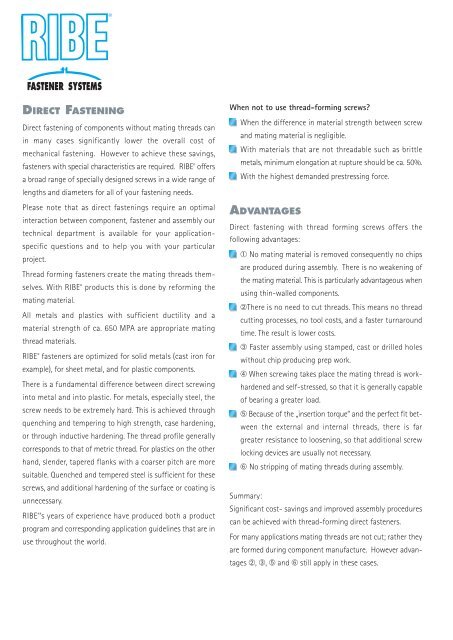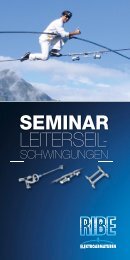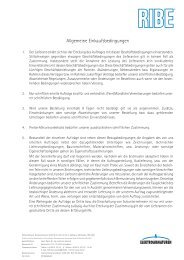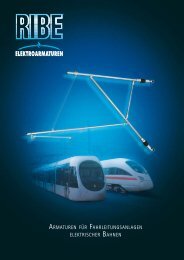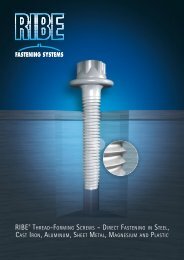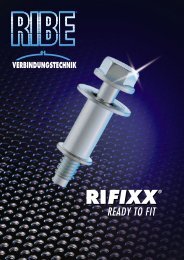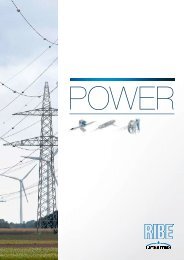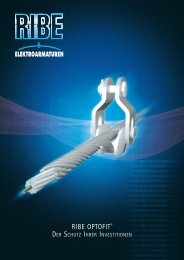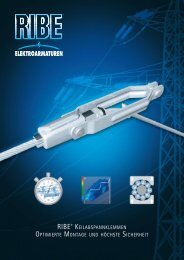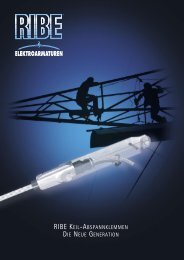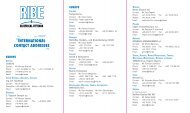RIBE thread-forming screws
RIBE thread-forming screws
RIBE thread-forming screws
- TAGS
- ribe
- screws
- www.ribe.de
Create successful ePaper yourself
Turn your PDF publications into a flip-book with our unique Google optimized e-Paper software.
DIRECT FASTENING<br />
Direct fastening of components without mating <strong>thread</strong>s can<br />
in many cases significantly lower the overall cost of<br />
mechanical fastening. However to achieve these savings,<br />
fasteners with special characteristics are required. <strong>RIBE</strong> ® offers<br />
a broad range of specially designed <strong>screws</strong> in a wide range of<br />
lengths and diameters for all of your fastening needs.<br />
Please note that as direct fastenings require an optimal<br />
interaction between component, fastener and assembly our<br />
technical department is available for your applicationspecific<br />
questions and to help you with your particular<br />
project.<br />
Thread <strong>forming</strong> fasteners create the mating <strong>thread</strong>s themselves.<br />
With <strong>RIBE</strong> ® products this is done by re<strong>forming</strong> the<br />
mating material.<br />
All metals and plastics with sufficient ductility and a<br />
material strength of ca. 650 MPA are appropriate mating<br />
<strong>thread</strong> materials.<br />
<strong>RIBE</strong> ® fasteners are optimized for solid metals (cast iron for<br />
example), for sheet metal, and for plastic components.<br />
There is a fundamental difference between direct screwing<br />
into metal and into plastic. For metals, especially steel, the<br />
screw needs to be extremely hard. This is achieved through<br />
quenching and tempering to high strength, case hardening,<br />
or through inductive hardening. The <strong>thread</strong> profile generally<br />
corresponds to that of metric <strong>thread</strong>. For plastics on the other<br />
hand, slender, tapered flanks with a coarser pitch are more<br />
suitable. Quenched and tempered steel is sufficient for these<br />
<strong>screws</strong>, and additional hardening of the surface or coating is<br />
unnecessary.<br />
<strong>RIBE</strong> ® ’s years of experience have produced both a product<br />
program and corresponding application guidelines that are in<br />
use throughout the world.<br />
When not to use <strong>thread</strong>-<strong>forming</strong> <strong>screws</strong>?<br />
When the difference in material strength between screw<br />
and mating material is negligible.<br />
With materials that are not <strong>thread</strong>able such as brittle<br />
metals, minimum elongation at rupture should be ca. 50%.<br />
With the highest demanded prestressing force.<br />
ADVANTAGES<br />
Direct fastening with <strong>thread</strong> <strong>forming</strong> <strong>screws</strong> offers the<br />
following advantages:<br />
➀ No mating material is removed consequently no chips<br />
are produced during assembly. There is no weakening of<br />
the mating material. This is particularly advantageous when<br />
using thin-walled components.<br />
➁There is no need to cut <strong>thread</strong>s. This means no <strong>thread</strong><br />
cutting processes, no tool costs, and a faster turnaround<br />
time. The result is lower costs.<br />
➂ Faster assembly using stamped, cast or drilled holes<br />
without chip producing prep work.<br />
➃ When screwing takes place the mating <strong>thread</strong> is work-<br />
hardened and self-stressed, so that it is generally capable<br />
of bearing a greater load.<br />
➄ Because of the „insertion torque“ and the perfect fit bet-<br />
ween the external and internal <strong>thread</strong>s, there is far<br />
greater resistance to loosening, so that additional screw<br />
locking devices are usually not necessary.<br />
➅ No stripping of mating <strong>thread</strong>s during assembly.<br />
Summary:<br />
Significant cost- savings and improved assembly procedures<br />
can be achieved with <strong>thread</strong>-<strong>forming</strong> direct fasteners.<br />
For many applications mating <strong>thread</strong>s are not cut; rather they<br />
are formed during component manufacture. However advantages<br />
➁, ➂, ➄ and ➅ still apply in these cases.


